A Search for The Boss: The Thing Inside Each Organism That is in It could be a Phospholipid Derivative
*Julius Adler
Departments of Biochemistry and Genetics, University of Wisconsin, USA
Submission: April 20, 2016; Published: July 26, 2016
*Corresponding author: ulius Adler, Departments of Biochemistry and Genetics, University of Wisconsin-Madison, Madison, Wisconsin 53706, USA, Email:adler@biochem.wisc.edu
How to cite this article: Julius A.A Search for The Boss: The Thing Inside Each Organism That is in Charge. Anatomy Physiol Biochem Int J. 2016; 1(1): 555555. DOI: 10.19080/APBIJ.2016.01.555555
Abstract
It is proposed that every organism is controlled by The Boss. The Boss is in charge of each organism’s behavior, metabolism, development, immune response, and reproduction. All organisms have perhaps the same Boss. This is an unknown mechanism. An example is behavior. In people and other primates, The Boss acts at the prefrontal cortex of the brain to direct the behavior of the organism by means of executive function. It is proposed that simpler versions of a prefrontal cortex occur also in other animals and in plants and in microorganisms. Thus The Boss directs the behavior of all organisms. The Boss could be a phospholipid derivative.
Keywords: Executive Function; Global Regulators; Biochemistry; Neurobiology; Genetics; Bacteriology
Introduction
This has been a century of great accomplishments in the biological sciences. We have learned a vast amount of what organisms do and how they do it, all the way from microorganisms to plants to animals including humans. But the search for what ties it all together (if anything) has been avoided and the answer is unknown.
“… we can only work in very narrow areas within certain fields. We do not know whether the contemporary road and method will eventually stumble against some fundamental barrier. We only recognize single elements in this puzzle, but the body adds and orders them in a way which is difficult to understand. Occasionally, one [not I] would like to believe that the human intellect is incapable of comprehending the conditions of its own biological functions. In any event, we are ignorant about the fortunes of our hitherto successful approach for the next hundred years and whether entirely new ways will have to be devised in order to continue our physiological studies.” – Karl E. Rothschuh “History of Physiology” [1].
Here are presented such “entirely new ways” for biology, namely that all organism have something in charge – “The Boss” – and that The Boss directs behavior, metabolism, development, immunological response, and reproduction. The Boss may be the same for all organisms.
Behavior, Metabolism, Development, Immunological Response, Reproduction
Behavior and its Control
Behavior in Humans and in other Primates: Starting in the 1870’s it became apparent to some psychologists that there is a part of the brain, the prefrontal cortex, that is master of the whole brain; see a review up to 1970 by the neurophysiologist Aleksandr Luria, who himself modernized this concept and studied syndromes resulting from deficiencies of the prefrontal cortex [2]. This part of the brain became known as the “central executive” through the research of the psychologist Alan Baddeley [3] or as the “executive brain” through the research of the neuropsychologist Elkhonon Goldberg [4], a student of Luria’s [4]; it is now known as “executive function” or “executive control”. For a review see Gold berg & Bougakiv [5] and Sam Gilbert & Paul Burgess [6].
According to the anatomist Korbina Brodman, working in 1906 [Fuster 7], the prefrontal cortex or its analogs account for 29% of the total cortex in humans, 17% in the chimpanzee, 11.5% in the gibbon and the macaque, 8.5% in the lemur, 7% in the dog, and 3.5% in the cat; for a modern version by Joaquín Fuster [7] see Figure 1.
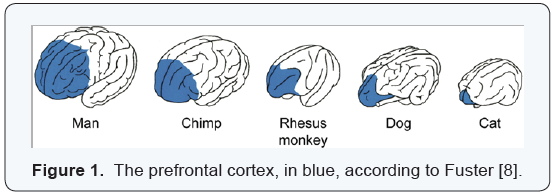
The prefrontal cortex of the brain is compared to that of the chief executive officer of an organization by Mateer CA et al. [8]. “Imagine the role of the executive officer of a large company, who has overriding control over the company’s action. This person sets goals, plans and organizes company activities to meet these goals, and decides when to start to do something, when to stop doing it, when to do something else, and when to do nothing at all... At a basic level, this is what the prefrontal cortex does for humans.”
In 1848 a construction foreman, Phineas P. Gage, suffered from an explosion that sent an iron rod through his brain. After the rod was removed, he turned from “the most efficient and capable man” into one with new personality traits: “fitful, irreverent… capricious and vacillating… he had the animal passions of a strong man.” So reports the neuroscientist Antonio Damasio in “Decartes’ Error: Emotion, Reason, and the Human Brain” [9]. Hanna Damasio studied Gage’s skull and found that it must have been the frontal lobe that was hurt. According to a more recent but similar case, studied by Paul Eslinger & Damasios [10] “the frontal lobe of the brain was damaged by a tumor that was removed, resulting in a turn of the patient’s emotional reactivity and in impaired ability to reach decisions though retaining a normal intellect. Such cases show that some part of the frontal lobe of the human brain is involved in emotion, reason, and decision-making” [Damasio A 9]. See also the classical work of [Brenda Milner] on removal of parts of the frontal lobe of humans. Milner also studied a patient who had amnesia as a result of a bilateral surgical ablation of parts of the hippocampus (Scoville and Milner 12). After death of the patient his brain was examined in detail based on histological scanning; besides lesions in the hippocampus, a small lesion in the orbitofrontal cortex was found (Annese et al. 13).
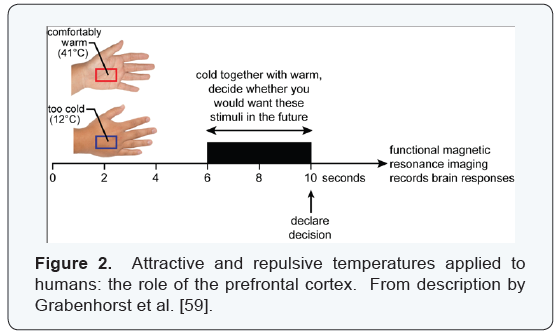
One function of the prefrontal cortex in humans and other primates is decision making, as reviewed by Jonathan Wallis [14]. An example of the role of the prefrontal cortex in human decision-making is provided by the research of the brain scientist Edmund Rolls et al. [15]. They used functional magnetic resonance imaging to measure the response when a person’s hand was exposed to pleasant warmth or unpleasant cold or the two together (Figure 2). When the two were applied together and the subject was asked to decide if he/she would want that again if it were available in the future, there was a response in the prefrontal cortex, but with either stimulus alone, or with the two together without needing a decision, responses were only elsewhere in the brain. In further experiments these authors came to a similar conclusion when an attractive odor was pitted against a repulsive odor, again in humans [Rolls ET et al. 16].
Another function of the prefrontal cortex in humans and other primates is working memory: knowing what to do even when the stimulus for doing it is removed. “Working memory,” reported Patricia Goldman & Rakic [17] “is the term applied to the type of memory that is active and relevant only for a short period of time, usually on the scale of seconds. A common example of working memory is keeping in mind a newly read phone number until it is dialed and then immediately forgotten.” For a review of working memory in primates see Postle BR [18]. See [Kandel ER 19] for a review of prefrontal cortex and working memory.
What is in Charge of the Behavior of “Simpler” Animals?
The Boss and executive function have not been reported in “simpler” animals so far.
The animal behaviorist in “Animal Minds: Beyond Cognition to Consciousness” Donald Griffen [20] presented evidence that all animals have mentality, and he developed the idea that zoologists should investigate questions of animal consciousness. He used examples from vertebrates such as dolphins and birds and from invertebrates such as honeybees. But plants and protists are not eligible, Griffin says “... animals are also clearly more than mobile metabolisms. They act [sic], that is they do things spontaneously, on their own. The complexity... distinguishes them in an important fashion from microorganisms, plants, and physical systems.… Since protozoa lack anything at all comparable to a central nervous system capable of storing and manipulating information, it seems highly unlikely that they could be capable of anything remotely comparable to conscious thinking.”
The central complex of insects is required for sensing attractants and repellents (Figure 3). The central complex is related to the mammalian brain (Figure 4). They are derived from a common ancient ancestor. ,Drosophila mutants have been isolated Vang & Adler [24] that failed to be attracted by anything tested (Figure 5) and failed to be repelled by anything tested, even though they are motile. They have a defect in the mechanism that dictates a behavioral response.
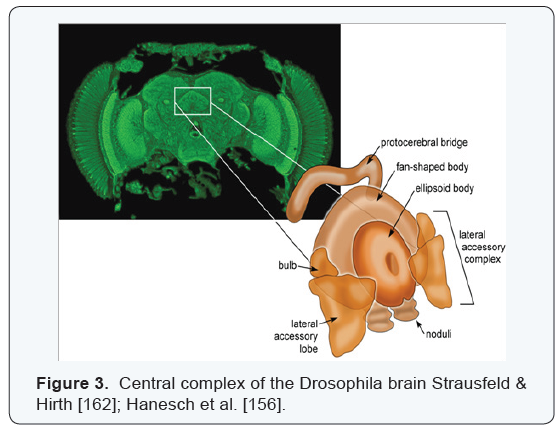
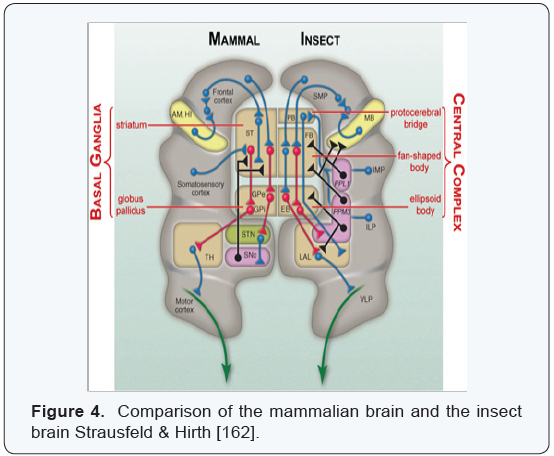
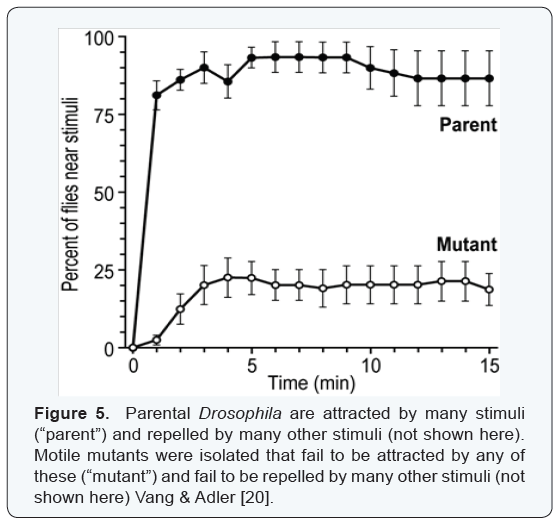
Decision making, a function of the prefrontal cortex in people and other primates, has been found in Drosophila, too According to Alder. The flies at one end of a tube largely refused to go to the other end containing attractant together with overpowering repellent, but mutants could be isolated which did go there. These mutants presumably had a defect in deciding what to do.
Analogous to the prefrontal cortex in humans and other primates, the central complex of the fly is presumed to be in control of behavior. Some thirty Drosophila mutants defective in the fly’s central complex have been isolated by Richard Strauss & Martin Heisenberg [26], Kirsa Neuser et al. [27], Joanna Young & Douglas Armstrong [28], and others. We found that three of these are defective in bringing about behavioral responses Vang & Adler [24]. Using them, one can learn how the central complex generates a behavioral response.
Working memory, a part of the prefrontal cortex first described in people and other primates, has now been found in insects, too. This was discovered by Roland Strauss et al. [27], who showed that Drosophila can remember the position of an object for several seconds after the object has been removed, as illustrated in (Figure 6). By using mutants, the authors [27] found that this behavior depends on ring neurons of the ellipsoid body in the brain’s central complex.
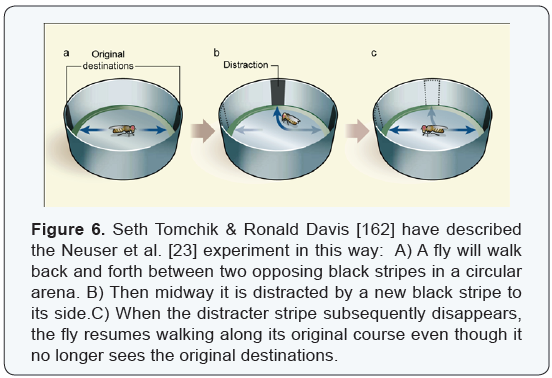
Charles Darwin’s study of the behavior and intelligence of earthworms is presented in his 1881 book, “The Formation of Vegetable Mould, through the Action of Worms with Observations on Their Habits.” [29] Earthworms plug the openings of their burrows with leaves. Darwin did experiments to study the worm’s reactions to variation in the shape of the leaves, for example he used cut leaves, pine needles, and “leaves” made from paper. He showed that the worm feels the shape of the leaves prior to grasping them and that it used judgment about the best way to pull the leaves into their burrow. Darwin said: “If worms have the power of acquiring some notions, however crude, of the shape of an object and of their burrows as seems to be the case, they deserve to be called intelligent; for they act in nearly the same manner as would a man under similar circumstances… One alternative alone is left, namely that worms, although standing low in the scale of organization, possess some degree of intelligence; this will strike every man as very improbable, but it will be doubted whether we know enough about the nervous system of the lower animals to justify our natural distrust of such a conclusion”.
What is in Charge of the Behavior of a Plant?
Evidence for The Boss and executive function in plants has not been presented, but it could be implied by some of the following work.
Studies by Charles Darwin and his son Francis on the behavior of plants, reported in 1881 in their book, “The Power of Movement in Plants”, led them to conclude, “Finally, it is impossible not to be struck with the resemblance between the forgoing movements of plants and many of the actions performed unconsciously by the lower animals ... Yet plants do not of course possess nerves or a central nervous system; and we may infer that as with animals such structures serve only for the more perfect transmission of impressions and for the more complete intercommunication of the several parts...We believe that there is no structure in plants more wonderful as far as its functions are concerned than the tip of the radicle [the root] ... It is hardly an exaggeration to say that the tip of the radical thus endowed, and having the power of directing the movements of the adjoining parts, acts like the brain of the lower animals” [26].
The plant physiologist Wilhelm Pfeffer [27] stated in his book “The Physiology of Plants”: “The fact that in large plants the power of growth and movement are not strikingly evident has caused plants to be popularly regarded as ‘still life’. Hence the rapid movements of sensitive Mimosa pudica were regarded as extraordinary for a plant… If mankind from youth upwards were accustomed to view nature under a magnification of 100 to 1000 times, or to perceive the activity of weeks or months performed in a minute, as is possible with the aid of a kinematograph, this erroneous idea would be entirely dispelled” Pfeffer W [27]. Pfeffer studied the “behavior” of plants, both rapid catching of insects and also slow growth-responses to environmental stimuli, called tropisms.
Jagadish Chandra Bose was first a physicist, working on electromagnetic radiation, then he spent thirty years studying electrical signaling in plants. His major conclusion, presented in “The Nervous Mechanisms of Plants” in 1926: “Ordinary plants, meaning those usually regarded as insensitive, exhibit the characteristic electric response already known in ‘sensitive’ plants. Ordinary plants were regarded at the time as inexcitable, because they did not respond to stimulation by an obvious movement … I was, however, able to show that every plant, and even each organ of every plant, is excitable and responds to stimulus by electric response of galvanotropic negativity … The most important fact established in plant-response was the nervous character of the impulse transmitted to a distance. My discovery of the excitatory polar action of an electric current and its transmission to a distance, proved that the conduction of excitation in the plant is fundamentally the same as that in the nerve of an animal” Bose [28].
Action potentials in plants have been extensively studied, see for example those of the Venus fly trap, the touch-sensitive Mimosa, and pea, as described by Clifford Slayman [29] and reported by Michael Sussman [30] thus action potentials occur in both carnivorous and non-carnivorous plants, but they are slower than those of the squid giant axon.
In “Plant neurobiology: an integrated view of plant signaling”, Eric Breuner [31] reviewed the evidence that the behavior which plants exhibit is coordinated across the whole organism by some form of integrated signaling, communication, and response system. Studies of the neurobiology of plants have been stimulated by the creation of the Society for Plant Neurobiology; in its 2006 symposium book, “Communication in Plants: Neuronal Aspects of Plant Life”, František Baluška et al. [32] and Peter Barlow say, “Roots represent the essential part of the plant whereas shoots can be dispensable … Each root apex is proposed to harbour brain-like units of the nervous system of plants ... All ‘brain units’ are interconnected via vascular strands (plant neurons) with their polarly-transported auxin (plant neurotransmitter), to form a neuronal system of plants” [32]. The Society in 2009 was renamed “The Society of Plant Signaling and Behavior” and its journal was renamed “Plant Signaling and Behavior.”
Daniel Chamovitz [33] published “What a Plant Knows, a Field Guide to the Senses” to review a plant’s equivalent of our senses: what a plant sees, smells, feels, etc. As an example, Chamovitz reviews how the parasitic not-green dodder plant locates its prey: it grows toward a certain chemical given off by a green plant such as the tomato and away from another chemical given off by a different green plant such as wheat, according to Consuelo De Moraes et al. [34]. But Chamovitz rejects the idea that plants are a subject for neurobiology [33].
What is in Charge of the Behavior of a Microorganism?
Evidence for The Boss and executive function in microorganisms has not been shown, but it could be implied in some of the following work. The physiologist Max Verworn, who studied unicellular organisms and nerve cells, wrote in 1889 in his book, “Psycho-Physiologische Protisten-Studien”: “My dear professor! When under your guidance I began my instruction in zoology, it was from the very beginning the life of the lowest organisms that interested me the most. For here, on the lowest level of life, within the framework of one single cell, all the phenomena of life which we observe in the higher organisms can be found in their most simple form … To be sure some physiologists do not yet recognize psychology as part of physiology; yet if physiology considers the investigation of the phenomena of life to be its task, then the consequences of this conception is obvious, for the psychic processes are just as well phenomena of all life as are the metabolism processes” Verworn [35]. Eukaryotic microorganisms and bacteria were included in Verworn’s studies.
The behavior of microorganisms was reviewed by Alfred Binet [36], the father of the IQ test, in his book “The Psychic Life of Micro-organisms, a Study in Experimental Psychology”: “I have endeavored in the following essay upon micro-organisms to show that psychological phenomena begin among the very lowest classes of beings; they are met with in every form of life, from the simplest cellule to the most complicated organism. It is they that are the essential phenomena of life, inherent in all protoplasm... Thus, even on the lowest rounds of the ladder of life, psychic manifestations are very much more complex than is usually believed”. Eukaryotic microorganisms and bacteria were included in Binet’s review.
Motile cells of animals have been studied: for example leukocytes, which are amoeboid cells of the immune system, by Martha Cathcart [37] and Connie Wong et al. [38]; and flagellated sperm interacting with egg, by Roy Kaplan et al. [39].
In the yeast Saccharomyces cerevisiae two haploid cells of opposite mating type, a and @, fuse by a chemotropic response to their pheromomes Cross, Hartwell et al. [40]. The mechanism of this fusion is being studied by use of mutants that fail here Arkowitz [41], Gelin-Licht [42].
Discostelium discoideum are social amoebae whose behavior has been studied by Peter Devreotes and others Swaney [43]. These cells depend on chemotaxis to find food and to survive starvation conditions. Their movement relies on the extension of pseudopods. Mutants missing various components have been isolated and studied.
The behavior of the ciliated protozoan Paramecium was placed on a mechanistic basis by the research of Herbert Jennings [44], Yutaka Naitoh & Roger Eckert [45], and Boris Martinac, Yoshiro Saimi & Ching Kung [46]. It was shown that the movement of Paramecium is regulated by electrical events caused by the flow of ions such as potassium and calcium, and that there is a genetic basis for this movement.
Engelmann discovered in 1881 that bacteria are attracted to light (“phototaxis”) Engelmann [47], and in the archaeon Halobacterium salinarum the role of microbial rhodopsin in phototaxis is now biochemically described Spudich [48]. Wilhelm Pfeffer [49] discovered in that bacteria are attracted and repelled by various chemicals (“chemotaxis”), and in the bacterium Escherichia coli a biochemical mechanism for chemotaxis has been summarized Adler [50], Hazelbauer [51], Crooks et al. [52]. Gliding motility and multicellular swarming in the bacterium Myxococcus xanthus has been studied by Dale Kaiser and by “David Zusman [53].
How Behavior is Controlled
For organisms in general, the mechanism of behavior and the control of behavior are summarized in Figure 7. There are sensory inputs, both for external and internal stimuli. Then the organism chooses what to do about these by means of decision making. That result is then sent to the final pathway, which dictates a behavioral response. Decision making is directed by executive function which in turn is influenced by The Boss.
The interaction between stimuli and decision making (Figure 7) has been studied/reported by Marcus Raichle [54,55], Dennis Bray [56], Björn Brembs [57] and Axel Gorostiza, Julien Colomb & Björn Brembs [58]. There is an active state that is present before stimuli are presented, then a different state upon presentation of stimuli. Although discovered in mammals Marcus Raichle [54,55], such a phenomenon occurs also in invertebrates and bacteria Dennis Bray [56]. A decision-making process has been reported by Alex Gorostiza, Julien Colomb & Björn Brembs [58].
Here are examples of decision making in the case of attractant together with repellent: in people Grabenhorst et al. [59], see (Figure 2); Rolls et al. [60]; dogs Andersson et al. [61]; insects Dethier [62], Tang & Guo [63], Zhang et al. [64], Yang et al. [65], Joseph et al. [66], Vang et al. [67], Adler & Vang [20] ; worms Ishihara et al. [68]; plants Liscum & Briggs [69], Hangarter [70]; and bacteria Tsang et al. [71], Adler & Tso [72], Schultz et al. [73]. These can be viewed as valuable for trying to find out if a study of conflicting behavior might yield information about executive function.
Especially valuable will be those cases above where it has been possible to isolate mutants that could involve a defect in decision making or in executive function and perhaps even in The Boss Tang & Guo [63], Ishihara et al. [68], Vang et al. [67], Zhang et al. [64], Yang et al. [65], Joseph et al. [66], Adler & Vang [20].
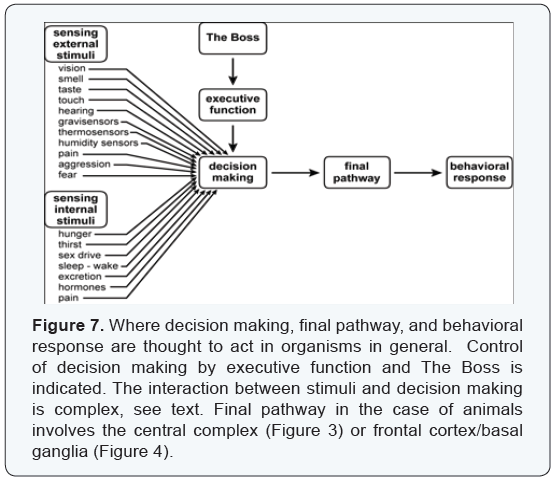
When there is a change in environment or a change internally, The Boss determines what is needed to compensate, and then executive function carries this out by way of decision making (Figure 7). For example, a bad taste may prevent an organism from consuming a needed substance, but if the organism is starved for that substance The Boss can change the system so that the valuable substance is anyway consumed. How that is achieved is presently unknown.
An example of change is shown in Figure 8, where a Drosophila mutant changed its property over a 20 day period: as it aged, the response changed: the mutant became attracted to attractant plus overpowering repellent where previously it was repelled Adler & Vang [20]. What is the mechanism for such a change? That needs to be discovered. In people, Altzheimer’s disease is such an age-dependent behavioral change that needs to be understood Selkoe et al. [74].
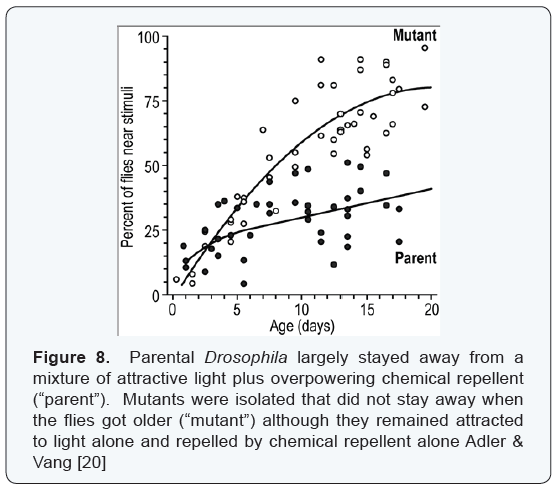
Metabolism and its Control
At first scientists learned about small molecules (for example glucose) and then about enzymes, then it became known that there are genes that made the enzymes, and now mechanisms are known that control the genes. Initially specific controls were discovered, like the operon that is in charge of the metabolism of lactose Jacob & Monod [75], Beckwith [76]. Then it was found that related operons could be controlled by a common regulator, the regulon Neidhardt [77], Beckwith [76], Neidhardt & Savageau [78]. Sets of operons are coordinately controlled by global regulators, as described by Susan Gottesman [79]. The global regulators of E. coli evident by 2003 have been reviewed by Augustino Martinez-Antonio & Julio Collado-Vides [80], see their figure reproduced here (Figure 9), which tells that there are seven global regulators that are sufficient for modulating the expression of 51% of the genes in E. coli. Thus a few global regulators have a large influence.
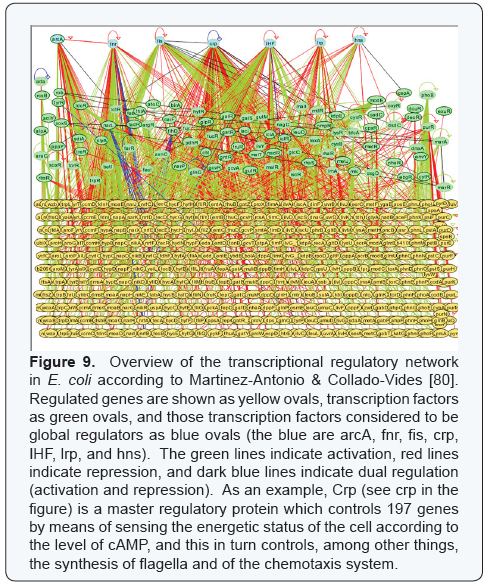
CsrA is a bacterial global regulator. Tony Romeo et al. [81] showed that CsrA, an RNA binding protein, can interact with RNAs of at least 721 genes. Some of these RNAs function positively to make the enzymes needed for the growth phase and some function negatively for inhibition of these enzymes in the approach to stationary phase.
Some further examples of global regulatory pathways follow. In the case of response to stress, E. coli represses its housekeeping genes and turns on genes for handling noxious conditions such as heat, a high salt concentration, radiation by ultraviolet light, acidic pH, and ethanol, have reported Gruber TM & Gross CA [82]. It does this by replacing the sigma factor for turning on housekeeping genes with sigma factors for turning on genes that mediate the emergency, thus regulating 225 genes – 203 positively and 22 negatively according to Tao Dong & Herb Shellhor [83]. Similarly, upon exposure to heat, hydrogen peroxide, or a high salt concentration, yeast represses about 600 genes related to synthesis of normally required proteins and induces about 300 other genes needed for the stress response, according to Audrey Gasch et al. [84]. This occurs partially through changes in chromatin brought about by means of deacetylation of histones in both coding and non-coding regions.
In a systems biology approach, Andrew Joyce & Bernhard Palsson [85] have shown that one can interpret genomic results to indicate that certain components are global regulators and others are genes for enzymes that are targets. They illustrate 104 regulators of E. coli that control 479 genes for target enzymes. Covert MW et al. [86] says, “We expect that after an effort of some years and many iterations of this process, regulatory network elucidation for E. coli will be essentially complete.” At that time one will be able to tell which components control all the rest.
Development and its Control
In the case of development, the hox genes of an embryo act to regulate genes that in turn regulate large networks of other genes; for example in Drosophila the hox genes regulate the genes that form the organs of each segment, including the genes that form appendages, according to William McGinnis and collaborators Pearson et al. [87].
Also in development, there is a general transcription factor, Lola, that regulates axon pathfinding in the Drosophila embryo. Edward Giniger, Liqun Leo, and collaborators have shown that the lola gene controls some of the earliest steps of development as well as later stages Spletter et al. [88]. This gene, which by alternative splicing makes 20 isoforms, regulates the expression of at least 1,000 to 1,500 other genes Gates [89]; unpublished data of Edward Giniger. Thus lola was called a “master regulator” by Giniger and coworkers: it orchestrates the appropriate expression of guiding factors, receptors, and signaling proteins that execute the guidance decisions of a given growth cone Madden et al. [90].The involvement of RNA in development has been studied by Scott Aoki et al. [91].
Immunological Response and its Control
In the case of immunological responses, it is the synthesis of lymphocytes from stem cells that is globally regulated. This regulator is Early B-cell Factor acting by way of Pax5, which is a transcription factor that activates 170 appropriate genes and represses 110 inappropriate genes, as documented by Cobaleda C et al. [92] and Lukin K et al. [93]. This action results in commitment to making the lymphocytes.
Reproduction and its Control
Mating in bacteria (“conjugation”) is the transfer of genetic material from a “male” into a “female” bacterium. This was discovered by Joshua Lederberg & Edward Tatum [93] and has been further studied to the present time Gomis-Rüth et al. [94]. In animals sex steroids are crucial for reproduction Guerriero [95]. In plants Sun Y et al. [96] and in bacteria Bode et al. [97] such steroids also occur but any function in reproduction is not yet determined.
For reviews see, Bell G [98] The Masterpiece of Nature: The Evolution and Genetics of Sexuality, Michod RE [99] The Evolution of Sex: an Examination of Current Ideas, Otto SP, Lenormand T [100] Evolution of sex: Resolving the paradox of sex and recombination.
The BOSS
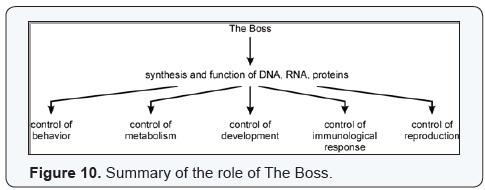
Behavior, metabolism, development, immunological responses, and reproduction, each discussed above, are controlled by The Boss. There is one Boss for all these functions. The Boss is perhaps the same for all organisms. What is The Boss and how does it control? The Boss is an unknown hypothetical mechanism that directs the synthesis and activity of DNA, RNA, and proteins and thereby is in charge of behavior, metabolism, development, immunological responses, and reproduction (Figure 10).
Essential Genes and the Boss
Now that we know the sequence of deoxynucleotides in the DNA of many different organisms (humans, rats, mice, fish, flies, worms, yeast, plants, bacteria, etc.), one can try to find out, for each organism, which are essential genes. Non-essential and essential genes are defined in the following way: Elimination of a non-essential gene (by mutation) still allows the organism to survive, while elimination of an essential gene (by mutation) leads to death. Essential genes are shown in (Figure 11). There are essential genes whose functions are still not fully known. Their functions need to be determined. And what, if anything, controls the various essential genes, what turns them on and off? That itself may be The Boss (Figure 11).
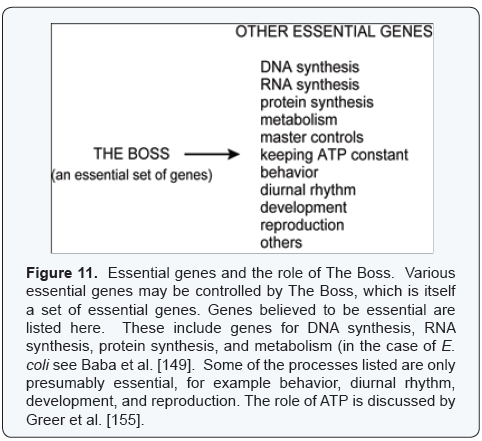
How many essential genes are there? The list of essential genes has not yet been completed in humans [total number of genes 20,000-25,000] International Human Genome Sequencing Consortium [101], in mice [total 20,00-25,000] Mouse Genome Sequencing Consortium [102], in zebra, fish [total about 25,000] Herrero et al. [103], and in Arabidopsis [total about 26,000] Arabidopsis [104] Genome Initiative, but in Drosophila there are about 3,700 essential genes out of a total of 13,379 genes Adams et al. [105], in C. elegans about 5,700 out of 19,427 C. elegans Sequencing Consortium [106], in Saccharomyces cerevisiae 1,105 out of 5,916 Giaver et al. [153], in E. coli 303 out of 4,377 Yamamoto, Riley et al. [107], in Mycoplasma genitalium 382 out of 482 Glass et al. [108].
The fact that E. coli has so few essential genes (303 of them), compared to a much larger number in eukaryotes, makes the search for The Boss seemingly easier in E. coli. Finding out which of the essential genes in E. coli, and in other organisms as well, controls behavior, metabolism, development, immune response, and reproduction, and determining how The Boss might control those essential genes, is one way for identifying The Boss.
Synthesis of DNA, RNA, and Protein in Relation to the Boss
Our knowledge of how DNA, RNA, and proteins are made, and how this is controlled, is now extensive for DNA synthesis Kaguni [109], Zakrzewska-Czerwinska et al. [110], Katayama et al. [111] and Masai et al. [112] for RNA synthesis including the spliseosome Wahl et al. [113], Jackson et al. [114], Malys & Mc Carthy [115], and Nakagawa et al. [116], Hoskins & Moore [117], and for protein synthesis Thomas & Chiang [118], Passalacqua et al. [119], Jiang & Pugh [120], Sorek & Cossart [121], and Kim & Park [81]. As an example, there is a time during the cell cycle when DNA synthesis is turned on and a time when it is turned off. The proposal here is that there is a master control, The Boss, that dictates what shall be the state of synthesis of DNA, RNA, and proteins.
A remarkable discovery, made by Burton et al. [122] and by Lupski et al. [123], is the existence of an operon in E. coli that directs all three of the most essential components of an organism: DNA (dnaG, which makes DNA primase), RNA (rpoD, which makes a part of RNA polymerase), and protein (rpsU, which makes a part of ribosomes). How is this dnaG-rpoDrpsU operon turned on and off? It seems likely that The Boss may control it. We are trying to obtain Boss mutants that fail in control of the dnaG-rpoD-rpsU operon. Links between DNA replication and RNA synthesis and between DNA replication and protein synthesis have already been proposed Chiaramello & Zyskind [124], Schreiber et al. [125], Wang et al. [126], Ferullo & Lovett [127], and Berthon et al. [128].
DNA other than Protein-Coding Genes
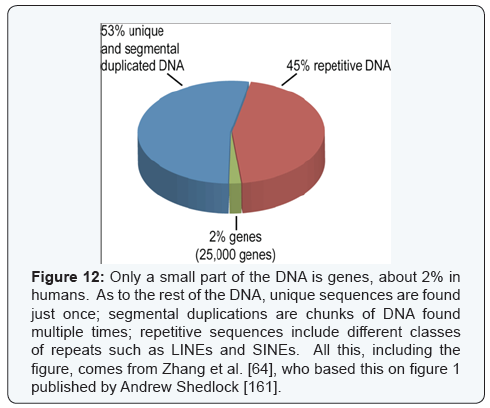
Bacteria and eukaryotes have very roughly a similar number of genes that code for proteins (400 to 5,000 for bacteria and about 6,000-25,000 for eukaryotes) but in bacteria most of the DNA is genes that code for proteins while in eukaryotes the DNAcoding genes are only a small part of the DNA. For example, in mammals it is only 1-2% Mercer et al. [129], see (Figure 12).
The amount of DNA/cell in bacteria is about 3-4 million base pairs/cell, about 12 million in yeast, about 180 million in flies, and about 3 billion in humans, in accord with approximate complexity (although some amphibians have 25 times as much DNA as human cells) Moore [130], Darnell [131].
Recently workers have shown that 70 to 90 percent of the eukaryotic DNA produces RNAs which do not make proteins and don’t end up being ribosomal RNA, transfer RNA, or known control RNA Mercer et al. [129], Nagalakshmi et al. [132], Wang et al. [133], Ozsolak et al. [134]. Some of such RNAs occur also in prokaryotes Sorek & Cossart [121], Siezen et al. [135] Thus a large part of the DNA in eukaryotes makes RNAs that control the organism in unknown ways. How such RNAs function is currently being investigated, both in eukaryotes Wang et al. [133], Ozsolak et al. [134] and in prokaryotes Sorek & Cossart [121], Siezen et al. [135]. These studies all point to non-coding RNA as a source of regulatory elements Carninci & Hayashizaki [136].
Thus the biological complexity of organisms is not reflected merely by the number of protein-making genes but by the number of other physiologically relevant interactions, say Michael Stumpf et al. [137]. The whole set of molecular interactions in cells has now become known as the “interactome”; this includes protein- DNA interactions, protein-RNA interactions, and protein-protein interactions, according to Sanchez C et al. [138]. Such interaction maps have been presented for Drosophila by Sanchez C et al. [138] and by Giot et al. [139]. The size of interactomes correlates much better with their apparent biological complexity than does the size of the genome; thus the number of interactions in humans is estimated to be about 650,000 compared to about 25,000 genes in the human genome, say Stumpf MPH et al. [137]. While much progress has been made in describing interactomes, we are still far away from completion because the interactome considers the whole organism and thus there is the need to collect a massive amount of information.
A novel method for studying regulators of transcription is chromatin immunoprecipitation (ChIP, also ChIP-chip) studied by Mooney RA et al. [140]. By this method, formation of a complex between DNA and proteins can now be studied on a global scale by isolating the complexed part, precipitating it with antibody to the protein, then identifying the DNA portion. This method has been successfully used in humans, other animals, yeast and bacteria. The results tell that certain parts of the DNA interact with transcription factors and with sigma factors that allow RNA synthesis to take place. In short, the regulatory parts of the DNA are being identified by this method. A different method focuses on the interplay between transcription factors and microRNAs, studied by what is called the “yeast one-hybrid (Y1H)” method; this work is also being widely pursued and especially by Marian Walhout’s group in C. elegans Martinez NJ & Walhout JM [141].
OK, there are regulators in charge of many functions. Do the regulators act independently of each other, or is there something that controls them? It seems that independent function of each regulator would result in competition and confusion incompatible with the life of the organism. Something must be coordinating them. It is The Boss. But that is only an idea at this time.
Chemistry of the Boss
What is The Boss? Of course it must be a gene or genes and it must be essential (Figure 11). The gene(s) for The Boss would seem to be made of DNA, but not necessarily, as any other inheritable material would work. Since RNA may have been present in organisms before there was any DNA, according to ideas of Carl Woese (142), David Baltimore (143), Walter Gilbert (144), and Raymond F, Gesteland & John F. Atkins (145) Gerald Joyce (146), Jennifer Doudna & Thomas Cech (147) and since The Boss may already have occurred in these earliest organisms, the Boss genes might well be RNA that does not go through any DNA at all, like many of the known RNA viruses Woese [142].
Latique C et al. [148] have successfully put an intact DNA genome isolated from one species of bacterium into another species, and their current work aims to do this transformation with a DNA genome that they have chemically synthesized Gibson DG et al. [149]. This work does not, however, rule out that The Boss is RNA independent of DNA or that it is any other inheritable material, since the recipient bacterium in their experiments contains all the non-DNA components of a cell.
Use of Mutants to identify the Boss
As described in II. A. 5, behavioral mutants that could possibly be defective in executive function and perhaps even in The Boss may have been isolated. One can also try to isolate such mutants that are defective in metabolism, development, immune response, and reproduction, and perhaps even in The Boss. The control of any essential gene by The Boss (Figure 11) could be studied by obtaining mutants that fail there.
Summary
- The behavior of various organisms – people and other primates, “simpler” animals, plants, microorganisms – has been reviewed and its direction by executive function and The Boss has been suggested:
- The role of global regulators directing metabolism has been reviewed.
- The role of master regulators directing development has been discussed.
- The control of immunological response has been discussed.
- The control of reproduction has been discussed.
- The idea that each organism is under control by The Boss has been presented. It is proposed that The Boss is in charge of the organism by way of controlling behavior, metabolism, development, immune response, and reproduction, as shown in (Figure 10).
- Synthesis of DNA, RNA, and proteins has been discussed in relation to The Boss (Figure 10).
- Essential genes have been discussed in relation to finding The Boss (Figure 11).
- DNA other than that which codes for synthesis of proteins has been discussed in relation to The Boss (Figure 12).
- As to the chemistry of The Boss, this is unknown. It could be DNA, or it could be RNA that functions independently of DNA.
- Genetic studies of The Boss and the control of behavior, metabolism, development, immune response, and reproduction will be carried out further.
Alternative Views
The Boss is a hypothetical entity; there is little or no evidence for it at this time.
An alternative is that there is no central boss at all but instead there is a different boss for each of the five parts. Another alternative is that it doesn’t require any boss at all to get interaction between behavior, metabolism, development, immune response, and reproduction. Each of these may interact with each other but without any control by a boss. So it is possible that there is no boss. There is no evidence to support any of these above alternatives at this time. It will require further research to determine which of these ideas (if any) is correct.
Acknowledgement
For valuable criticisms here (some of it devastating), I thank Buzz Baldwin, Dale Kaiser, Ching Kung, Bob Lehman, David Nelson, and Sandy Parkinson, and also the members of my laboratory. I especially thank Lar Vang for discussions. Some of the research on Drosophila and on E. coli presented here was carried out by recent and current undergraduate students. I am most grateful to The Camille and Henry Dreyfus Foundation for supporting our research by undergraduates the past six years by means of their Senior Scientist Mentor Program. I thank Laura Vanderploeg for beautiful artwork.
References
- Rothschuh KE (1973) History of Physiology. Translated from German by Risse GB, Krieger RE, Publishing Co., Huntington, New York, USA, pp. 360-361.
- Luria AR (1973) The Working Brain, an Introduction to Neuropsychology, translated by Basil Haigh, Penguin Books Ltd, pp. 79-99, 187-225.
- Baddeley A (1996) Exploring the central executive. Quar J Exp Psychol 49A(1): 5-28.
- Goldberg E (2001) The Executive Brain, Frontal Lobes and the Civilized Mind. Oxford University Press, USA.
- Goldberg EM, Bougakov DH (2007) Goals, executive control, and action. In: Baars BJ & Gage NM (Eds.), Cognition, Brain, and Consciousness: Introduction to Cognitive Neuroscience, Elsevier, pp. 343-366.
- Gilbert SJ, Burgess PW (2008) Executive function. Curr Biol 18(3): R110-R114.
- Fuster JM (2008) The Prefrontal Cortex. Elsevier Academic Press.
- Mateer CA, Sira CS, O’Connel ME (2005) Putting Humpty Dumpty together again: the importance of integrating cognitive and emotional interventions. J Head Trauma Rehab 20(1): 62-75.
- Damasio A (1994) Decartes’ Error: Emotion, Reason, and the Human Brain. Harper Collins.
- Eslinger PJ, Damasio AR (1985) Severe disturbance of higher cognition after bilateral frontal lobe ablation: patient EVR. Neurol 35(12): 1731-1741.
- Milner B (1982) Some cognitive effects of frontal-lobe lesions in man. Phil Trans R Soc Lond B 298(1089): 211-226.
- Wallis JD (2007) Orbitofrontal cortex and Its contribution to decisionmaking. Ann Rev Neurosci 30: 31-56.
- Grabenhorst F, Rolls ET, Parris BA (2008) From affective value to decision-making in the prefrontal cortex. Eur J Neurosci 28(9): 1930- 1939.
- Rolls ET, Grabenhorst F, Parris BA (2009) Neural systems underlying decisions about affective odors. J Cog Neurosci 22(5): 1069-82.
- Goldman-Rakic PS (1995) Cellular basis of working memory. Neuron 14(3): 477-485.
- Postle BR (2006) Working memory as an emergent property of the mind. Neurosci 139(1): 23-38.
- Kandel ER (2006) In Search of Memory, the Emergence of a New Science of Mind. J Clin Invest 116(5) : 1131.
- Griffin D (2001) Animal Minds: Beyond Cognition to Consciousness. University of Chicago Press, pp. 81, 271-272.
- Adler J Vang LL (2016) Decision making by Drosophila flies. Bio Rxiv 2016.
- Vang LL, Adler J (2016) Drosophila mutants that are motile but respond poorly to all stimuli tested: Mutants that have a large defect in interaction with stimuli or in executive function. bioRxiv.
- Strauss R, Heisenberg M (1993) A higher control center of locomotor behavior in the Drosophila brain. J Neurosci 13(5): 1852-1861.
- Neuser K, Triphan T, Mronz M, Poeck B, Strauss R (2008) Analysis of a spatial orientation memory in Drosophila. Nature 453(7199): 1244- 1247.
- Young JM, Armstrong JD (2010) Structure of the adult central complex in Drosophila: Organization of distinct neuronal subsets. J Comp Neurol 518(9): 1500-1524.
- Darwin C (1881) The Formation of Vegetable Mould, through the Action of Worms with Observations on Their Habits.
- Darwin C, Darwin F (1996) The Power of Movement in Plants. Da Copa Press, pp. 571-573.
- Pfeffer W (1897) Pflanzenphysiologie, Leipzig; The Physiology of Plants, translated by AJ Ewart, 1906, Oxford at the Clarendon Press.
- Bose JC (1926) The Nervous Mechanisms of Plants. Longmans, Green and Co.
- Slayman CL (1993) Channels, pumps, and osmotic machines in plants: A tribute to W. J. V. Osterhout. In: Barlow RB et al. In The Biological Century, Harvard University Press, pp. 120-149.
- Sussman MR (1992) Shaking Arabidopsis thaliana. Science 256(5057): 619.
- Breuner E (2006) Plant neurobiology: an integrated view of plant signaling. Trends Plant Sci 11(8): 413-419.
- Baluška F, Volkmann D, Hlavacka A, Mancuso S, Barlow PW (2006) Neurobiological view of plants and their body plan. In Communication in Plants: Neuronal Aspects of Plant Life,. Springer-Verlag, 19-36.
- Chamovitz D (2012) What a Plant Knows, a Field Guide to the Senses. Scientific American / Farrar, Straus and Giroux.
- Runyon JB, Mescher MC, De Moraes CM (2006) Volatile chemical cues guide host location and host selection by parasitic plants. Science 313(5795): 1964-1967.
- Verworn M (1889) Psychophysiologische Protistenstudien. Experimentelle Untersuchungen., Jena. Translated by M Wohl, Verlag von Gustav Fischer.
- Binet A (1889) The Psychic Life of Micro-organisms, a Study in Experimental Psychology. Open Court Publishing Co, Chicago, USA.
- Cathcart MK (2009) Signal-activated phospholipase regulation of leukocyte chemotaxis. J Lipid Res 50 supplement : S231-S236.
- Wong CHY, Heit B, Kubes P (2010) Molecular regulators of leukocyte chemotaxis during inflammation. Cardiovasc Res 86(2): 183-191.
- Armon L, Caplan SR, Eisenbach M, Friedrich BM (2012) Testing human sperm chemotaxis: How to detect biased motion in population assays. PLoS ONE 7(3): 1-7.
- Cross F, Hartwell LH, Jackson C, Konopka JB (1988) Conjugation in Saccharomyces cerevisiae. Ann Rev Cell Biol 4: 429-457.
- Arkowitz RA (2009) Chemical gradients and chemotropism in yeast. Cold Spring Harb Perspect Biol 1(2): 1-19.
- Gelin-Licht R, Paliwal S, Conlon P, Levchenko A, Gerst JE (2012) Scp160-dependent mRNA trafficking mediates pheromone gradient sensing and chemotropism in yeast. Cell Rep 1(5): 483-494.
- Swaney KF, Huang C-H, Devreotes PN (2010) Eukaryotic chemotaxis: A network of signaling pathways controls motility, directional sensing, and polarity. Annu Rev Biophys 39:265-289.
- Jennings H (1906) Behavior of the Lower Organisms. Columbia University Press.
- Naitoh Y, Eckert R (1973) Sensory mechanisms of Paramecium II. Ionic basis of the hyperpolarizing mechanoreceptor potential. J Exp Biol 59(1): 53-65.
- Martinac B, Saimi Y, Kung C (2008) Ion channels in microbes. Physiol Rev 88(4): 1449-1490.
- Engelmann TW (1881) Neue Methode zur Untersuchung der Sauerstoff- ausscheidung pflanzlicher und thierischer Organismen. Pflug Arch gesam Physiol 25(1): 285-448.
- Spudich JL (2006) The multilateral microbial sensory rhodopsins. Trends Microbiol 14: 480-487.
- Pfeffer W (1883) Lokomotorische Richtungsbewegungen duch chemische Reize. Deut botan Ges Ber 1: 524-533.
- Adler J (2011) My life with nature. Annu Rev Biochem 80: 42-70.
- Hazelbauer GL (2012) Bacterial chemotaxis: the early years of molecular studies. Annu Rev Microbiol 66: 285-303.
- Crooks JA, Stilwell MD, Oliver PM, Zhong Z, Weibel DB (2015) Decoding the chemical language of motile bacteria by using high-throughput microfluidic assays. ChemBioChem 16(15): 2151-2155.
- Kaiser D. (2008) Myxococcus – from single-cell polarity to complex multicellular patterns. Ann Rev Genetics 42: 109-130.
- Raichle ME (2010) Two views of brain function. Trends Cogn Sciences 14(4): 180-190.
- Raichle ME, MacLeod AM, Snyder AZ, Powers WJ, Gusnard OA (2001) A default mode of brain function. Proc Natl Acad Sci USA 98(2): 676- 682.
- Bray D (2014) Intrinsic activity in cells and the brain. Mol Bio Cell 25(6): 737-78.
- Brembs B (2015) What are brains good for, anyway? Lecture in “Brain, cognition, behavior, evolution: Polyglot to monoglot”, Institute for Advanced Studies, Sao Paulo, 29 June 2015, organized by J Hogan.
- Gorostiza EA, Colomb J, Brembs B (2016). A value-based behavioral choice underlies phototaxis in Drosophila. Anim Behav Cognit 2016.
- Grabenhorst F, Rolls ET, Parris BA (2008) From affective value to decision-making in the prefrontal cortex. Eur J Neurosci 28(9): 1930- 1939.
- Rolls ET, Grabenhorst F, Parris BA (2009) Neural systems underlying decisions about affective odors. J Cog Neurosci 22(5): 1069-82.
- Andersson B, Landgren S, Olsson L, Zotterman Y (1950) The sweet taste fibers of the dog. Acta Physiol Scand 21(2-3): 105-119.
- Dethier V (1955) The Physiology and histology of the contact chemoreceptors of the blowfly. Quart Rev Biol 30(4): 348-371.
- Tang S, Guo A (2001) Choice behavior of Drosophila facing contradictory visual cues. Science 294: 1543-1547.
- Zhang K, Guo J, Peng Y, Xii W, Guo A (2007) Dopamine-mushroom body circuit regulates saliency-based decision-making in Drosophila. Science 316(5833): 1901-1904.
- Yang C, Belawat P, Hafen E, Jan LY, Jan Y-N (2008) Drosophila egglaying site selection as a system to study simple decision-making processes. Science 319(5870): 1679-1683.
- Joseph RM, Devineni AV, King IFG, Heberlein U (2009) Oviposition preference for and positional avoidance of acetic acid provide a model for competing behavioral drives in Drosophila. Proc Natl Acad Sci USA 106(27): 11352-11357.
- Vang LL, Medvedev AV, Adler J (2012) Simple ways to measure behavioral responses of Drosophila to stimuli and use of these methods to characterize a novel mutant. PLoS ONE 7(5): e37495.
- Ishihara T, Iino Y, Mohri A, Mori I, Gengyo-Ando K, et al. (2002) HEN- 1, a secretory protein with an LDL receptor motif, regulates sensory integration in Caenorhabdidis elegans. Cell 109(5): 639-649.
- Liscum E, Briggs WR (1996) Mutations of Arabidopsis in potential transduction and response component of the phototropic signaling pathway. Plant Phys 112(1): 291-296.
- Hangarter RP (1997) Gravity, light, and plant form. Plant Cell Envir 20:796-800.
- Tsang N, Macnab RM, Koshland DE Jr (1973) Common mechanism for repellents and attractants in bacterial chemotaxis. Science 181(4094): 60-63.
- Adler J Tso WW (1974) “Decision”-making in bacteria: chemotactic response of Escherichia coli to conflicting stimuli. Science 184:1292- 1294.
- Schultz D, PG Wolynes, EB Jacob, JN Onuchic (2009) Deciding fate in adverse times: sporulation and competence in Bacillus subtilis. Pro Nat Acad Sci USA 106(50): 21027-21034.
- Selkoe DJ, Mandelkow E, Holzman DM, editors (2012) The Biology of Alzheimer Disease, Cold Spring Harb Lab Press. 2(1).
- Jacob F, Monod J (1961) Genetic regulatory mechanisms in the synthesis of proteins. J Mol Biol 3: 318-356.
- Beckwith J (1996) The operon: an historical account in Escherichia coli and Salmonella Cellular and Molecular Biology. American Socierty for Microbiology Press 1227-1231.
- Neidhart FC (1987) Multigene systems and regulons in Escherichia coli and Salmonella typhimurium Cellular and Molecular Biology. American Society for Microbiology Press 1313-1317.
- Neidhart FC, Savageau MA (1996) Regulation beyond the operon in Escherichia coli and Salmonella Cellular and Molecular Biology. American Society for Microbiology Press 1310-1324.
- Gottesman S (1984) Bacterial regulation: global regulatory networks. Ann Rev Gen 18: 415-441.
- Martinez-Antonio A, Collado-Vides J (2003) Identifying global regulators in transcriptional regulatory networks in bacteria. Cur Opin Microbiol 6(5): 482-489.
- Edwards AN, Patterson-Fortin LM, Vakulskas CA et al. (2011) Circuitry linking the Csr and stringent response global regulatory systems. Mol Microbiol 80 (6):1561-1580.
- Gruber TM, Gross CA (2003) Multiple sigma subunits and the partitioning of bacterial transcription space. Ann Rev Microbiol 57: 441-466.
- Dong T, Schelhorn HE (2009) Control of RpoS in global gene expression of Escherichia coli in minimal medium. Mol Gen Genet 281(1): 19-33.
- Alejandro Osorio AL, Huebert DJ, Porcaro DT, Sonntag ME, Nillasithanukroh S, et al. (2009) The histone deacetylase Rpd3p is required for transient changes in genomic expression in response to stress. Genome Biol 10(5): R57.
- Joyce AR, Palsson BO (2006) The model organism as a system: integrating ‘omics’ data sets. Nat Rev 7: 198-210.
- Covert MW, Knight EM, Reed JL, Herrgard MJ, Palsson BO (2004) Integrating high-throughput and computational data elucidates bacterial networks. Nature 429(6987): 92-96.
- Pearson JC, Lemons D, McGinnis W (2005) Modulating hox gene functions during animal body patterning. Nat Rev Gen 6(12): 893- 904.
- Spletter ML, Liu J, Liu J, Su H, Giniger E, et al. (2007) Lola regulates Drosophila olfactory projection neuron identity and targeting specificity. Neur Dev 2: 1-17.
- Gates MA (2008) PhD thesis, From transcription to axon guidance: uncovering downstream effectors of longitudinals lacking in Drosophila melanogaster, University of Washington, Seattle, WA, USA.
- Madden K, Crowner D, Giniger E (1999) Iola has the properties of a master regulator of axon-target interaction for SNb motor axons of Drosophila. Dev Biol 213: 301-313.
- Aoki ST, Kershner AM, Bingman CA, Wickens M, Kimble J (2016) PGL germ granule assembly protein is a base-specific, single-stranded RNase. Proc Natl Acad Sci USA 113(5): 1279-1284.
- Lukin K, Fields S, Hartley J, Hagman J (2008) Early B cell factor: regulator of B lineage specification and commitment. Sem Immunol 20(4): 221-257.
- Cobaleda C, Schebesta A, Delogu A, Busslinger M (2007) Pax5: the guardian of B cell identity and function. Nat Immunol 8(5): 463-470.
- Lederberg J, Tatum EL (1946) Gene recombination in the bacterium Escherichia coli. J. Bacteriol. 53(6): 673-684.
- Gomis-Rüth FX, Coll M (2006) Cut and move: protein machinery for DNA processing in bacterial conjugation. Curr Op Struct Biol 16(6): 744-752.
- Guerriero G (2009) Vertebrate sex steroid receptors: Evolution, ligands, and neurodistribution. Ann NY Acad Sci 1163: 154-168.
- Sun Y, Fan X-Y, Cao D-M, Tang W, He K, et al. (2010) Integration of brassinosteroid signal transduction with the transcription network for plant growth regulation in Arabidopsis. Develop Cell 19(5): 765- 777.
- Bode HB, Zeggel B, Silakowski B, Wenzel SC, Reichenbach H, et al. (2003) Steroid biosynthesis in prokatyotes: identification of myxobacterial steroids and cloning of the first bacterial 2,3(S)- oxidosqualene cyclase from the myxobacterium Stigmatella aurantiaca. Molec Microbiol 47(2): 471-481.
- Bell G (1982) The Masterpiece of Nature: The Evolution and Genetics of Sexuality. Univ. Calif. Press, Berkeley.
- Michod RE, Levin BR (1988) The Evolution of Sex: An Examination of Current Ideas. Sinauer, Sunderland, Mass.
- Otto SP, Lenormand T (2002) Evolution of sex: resolving the paradox of sex and recombination. Nat Rev Genetics 3(4): 252-261.
- International Human Genome Sequencing Consortium (2001) Initial sequencing and analysis of the human genome. Nature 409(6822): 860-921.
- Mouse Genome Sequencing Consortium (2002) Initial sequencing and comparative analysis of the mouse genome. Nature 420(6915): 520-562.
- Herrero J, Muffato M, Beal K, Fitzgerald S, Gordon L, et al. (2016) Ensembl comparative genomics resources.
- Arabidopsis Genome Initiative (2000) Analysis of the genome sequence of the flowering plant Arabidopsis thaliana. Nature 408(6814): 796-815.
- Adams MD, Celniker SE, Holt RA, Evans CA, Gocayne JD, et al. (2000) The genome sequence of Drosophila melanogaster. Science 287 (5461): 2185-2195.
- C elegans Sequencing Consortium (1998) Genome sequence of the nematode C. elegans: a platform for investigating biology. Science 282(5396): 2012-2018.
- Yamamoto N, Kiniyo S, Ioka-Nakamichi T, Yoshino M, Baba M, et al. (2006) Integrative functional analysis of essential genes in Escherichia coli. Presented at 3rd International E. coli Alliance Conference on Systems Biology, Jeju Island, Republic of Korea, p. 24.
- Glass JI, Assad-Garcia N, Alperovich N, Yooseph S, Lewis MR, et al. (2006) Essential Genes of a Minimal Bacterium. Proc Nat Acad Sci USA 103(2): 425-430.
- Kaguni JM (2006) DnaA: Controlling the Initiation of bacterial DNA replication and more. Ann Rev Microbiol 60: 351-371.
- Zakrzewska-Czerwińska J, Jakimowicz D, Zawilak-Pawlik A, Messer W (2007) Regulation of the initiation of chromosomal replication in bacteria. FEMS Microbiol Rev 31(4): 378-387.
- Katayama T, Ozaki S, Keyamura K, Fujimitsu K (2010) Regulation of the replication cycle: conserved and diverse regulatory systems for DnaA and oriC. Nat Rev Microbiol 8(3): 163-170.
- Masai H, Matsumoto S, You Z, Yoshizawa-Sugata N, Oda M (2010) Eukaryotic chromosome DNA replication: where, when, and how?. Ann Rev Biochem 79: 89-130.
- Wahl MC, Will CL, Luehrmann R (2009) The spliceosome: design principles of a dynamic RNP machine. Cell 136(4): 701-718.
- Jackson RJ, Hellen CUT, Pestova TV (2010) The mechanism of eukaryotic translation initiation and principles of its regulation. Nat Rev Mol Cell Biol 11(2): 113-127.
- Malys N, McCarthy JEG (2010) Translation initiation: variations in the mechanism can be anticipated. Cell Mol Life Sci 68(6): 991-1003.
- Nakagawa S, Niimura Y, Miura K-I, Gojobori T (2010) Dynamic evolution of translation initiation mechanisms in prokaryotes. Proc Nat Acad Sci USA 107(14): 6382-6387.
- Hoskins AA, Moore MJ (2012) The spliceosome: a flexible, reversible macromolecular machine. Trends Biochem Sci 37(5): 179-188.
- Thomas MC, Chiang C-M (2006) The general transcription machinery and general cofactors. Crit Rev Biochem Molec Biol 41(3): 105-17.
- Passalacqua KD, Varadarajan A, Ondov BD, Okou DT, Zwick ME, et al. (2009) Structure and complexity of a bacterial transcriptome. J Bact 191(10): 3203-3211.
- Jiang C, Pugh BF (2009) Nucleosome positioning and gene regulation: advances through genomics. Nat Rev Gen 10(3): 161-172.
- Sorek R, Cossart P (2010) Procaryotic transcriptomics: a new view on regulation, physiology and pathogenicity. Nat Rev Genet 11(1): 9-16.
- Burton ZF, Gross CA, Watanabe KK, Burgess RR (1983) The operon that encodes the sigma unit of RNA polymerase also encodes ribosomal protein S21 and DNA primase in E. coli K12. Cell 32(2): 335-349.
- Lupski JR, Smiley BS, Godson GN (1983) Regulation of the r p s U - dnaG-rpoD macromolecular synthesis operon and the initiation of DNA replication in Escherichia coli K-12. Mol Gen Genetics 189(1): 48-57.
- Chiaramello AE, Zyskind JW (1990) Coupling of DNA replication to growth rate in Escherichia coli: a possible role for guanosine tetraphosphate. J Bact 172(4): 2013-2019.
- Schreiber G, Ron E, Glaser G (1995) ppGpp-mediated regulation of DNA replication and cell division in Escherichia coli. Cur Microbiol 30(1): 27-32.
- Wang Z, Gerstein M, Snyder M (2009) RNA-Seq: a revolutionary tool for transcriptomics. Nat Rev Gen 10(1): 57-63.
- Ferullo DJ, Lovett ST (2008) The stringent response and cell cycle arrest in Escherichia coli. PLoS Genet 4(12): 1-9.
- Berthon J, Fujikane R, Forterre P (2009) When DNA replication and protein synthesis come together. Trends Biochem Sci. 34(9): 429- 434.
- Mercer TR, Dinger ME, Sunkin SM, Mehler MF, Mattick JS (2008) Specific expression of long noncoding RNAs in the mouse brain. Proc Nat Acad Sci USA 105(2): 716-721.
- Moore GP (1984) The C-value paradox. BioSci 34: 425-429.
- Darnell JE (2011) RNA, Life’s Indispensible Molecule. Cold Spring Harbor Laboratory Press. RNA 17(10): 771–1774.
- Nagalakshmi U, Wang Z, Waern K, Shou C, Raha D, et al. (2008) The transcriptional landscape of the yeast genome defined by RNA sequencing. Science 320(5881): 1344-1349.
- Wang JD, Sanders GM, Grossman AD (2007) Nutritional control of elongation of DNA replication by (p)ppGpp. Cell 128(5): 865-875.
- Ozsolak F, Platt AR, Jones DR, Reifenberger JG, Sass LE, et al. (2009) Direct DNA sequencing. Nature 461: 814-819.
- Siezen RJ, Wilson G, Todt T (2010) Prokaryotic whole-transcriptome analysis: deep sequencing and tiling arrays. Microb Biotech 3(2): 125-130.
- Carninci P, Hayashizaki Y (2007) Noncoding RNA transcription beyond annotated genes. Curr Opin Genet Devel 17 (2): 139-144.
- Stumpf MPH, Thorne T, deSilva E, Steward R, An H, et al. (2008) Estimating the size of the human interactome. Proc Nat Acad Sci USA 105(19): 6959-6964.
- Sanchez C, Lachaize C, Janody F, Bellon B, Roeder L, et al. (1999) Grasping at molecular interactions and genetic networks in Drosophila melanogaster using FlyNets, an internet database. Nucl Acid Res 27(1): 89-94.
- Giot L, Bader JC, Brouwer C, Chaudhuri A, Kuang B, et al. (2003) A protein interaction map for Drosophila melanogaster. Science 302(5651): 1727-1736.
- Mooney RA, Davis SE, Peters JM, Rowland JL, Ansari AZ, et al. (2009) Regulator trafficking on bacterial transcription units in vivo. Mol Cell 33(1): 97-108.
- Martinez NJ, Walhout JM (2009) The interaction between transcription factors and microRNAs in genome-scale regulatory networks. BioEssays 31(4): 435-445.
- Woese C (1968) The Genetic Code. Harper & Row, pp. 179-195.
- Baltimore D (1980) Evolution of RNA viruses. Ann N Y Acad Sci 354: 492-497.
- Gilbert W (1986) Origin of life, the RNA world. Nature 319: 618.
- Gesteland RF, Atkins JF, editors (1993) The RNA World, The Nature of Modern RNA Suggests a Prebiotic RNA World. Cold Spring Harb Lab Press.
- Joyce GF (2002) The antiquity of RNA-based evolution. Nature 418(6894):214-221.
- Doudna JA, Cech TR (2002) The chemical repertoire of natural ribozymes. Nature. 418(6894):222-228.
- Latique C, Glass J, Alperowich N, Pieper R, Parmur PP, et al. (2007) Genome transplantation in bacteria: changing one species to another. Science 317(5838): 632-638.
- Gibson DG, Benders G, Andrews-Pfankoch C, Denisova EA, Baden- Tilson H, et al. (2008) Complete chemical synthesis, assembly and cloning of a Mycoplasma genitalium. Science 319(5867): 1215-1220.
- Baba T, Ara T, Hasegawa M, Takai Y, Okumura Y, et al. (2006) Construction of Escherichia coli K-12 in-frame single-gene knockout mutants: the Keio collection. Mol Sys Biol 2(1).
- Giaever G, Chu AM, Ni L, Connelly C, Riles L, et al. (2002) Functional profiling of the Saccharomyces cerevisae genome. Nature 418(6896): 387-391.
- Greer EL, Oskoui PR, Banko MR, Maniar JM, Gygi MP, et al. (2007) The energy sensor AMP-activated protein kinase directly regulates the mammalian FOXO3 transcription factor. J Biol Chem 282(41): 30107-30119.
- Hanesch U, Fischbach K-F, Heisenberg M (1989) Neuronal architecture of the central complex in Drosophila melanogaster. Cell Tissue Res 257(2): 343-366.
- Kaiser D, Warrick H (2011) Myxoxoccus xanthus swarms are driven by growth and regulated by a pacemaker. J Bacteriol 193(21): 5898- 5904.
- Luria AR (1980) Higher Cortical Functions in Man, second American edition, translated by Basil Haigh, Basic Books, Inc, pp. 246-365.
- Selkoe DJ, Mandelkow E, Holzman DM, editors (2012) The Biology of Alzheimer Disease, Cold Spring Harb Lab Press. 2(1).
- Shedlock AM (2006) Exploring frontiers in the DNA landscape: An introduction to the symposium “Genome Analysis and the Molecular Systematics of Retroelements”. Syst Biol 55(6): 871-874.
- Strausfeld NJ, Hirth F (2013) Deep homology of arthropod central complex and vertebrate basal ganglia. Science 340 (6129): 157-161.
- Tomchik SM, Davis RL (2008) Out of sight, but not out of mind. Nature 453(7199): 1192-1194.






























